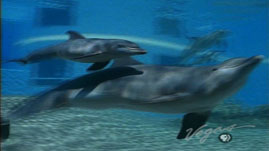Teachers' Domain - Digital Media for the Classroom and Professional Development
User: Preview

Source: Vegas PBS SAT-CHAT Series: “Dolphin CHAT”
In this video segment from the Science and Technology Chat series, marine biologist Julie Wignall, director of the Mirage Resort Dolphin Habitat, describes various aspects of dolphin pregnancy, calving, and care. Staff members check a pregnant dolphin's physical health and view images of an unborn calf. The video includes footage of a dolphin birth and reveals how a dolphin calf learns to nurse underwater and swim in its mother's slipstream.
Dolphins belong to the order Cetacea, which also includes whales and porpoises. Cetaceans are adapted to living in water, with sleek, hairless bodies and a single blowhole used for breathing air. To better understand animals, including dolphins, beyond their distinctive physical features, scientists often observe them in captivity. The ongoing studies at the artificial research habitat featured in this video provide marine biologists like Julie Wignall with important insights into dolphin reproductive behavior.
Once a female dolphin reaches sexual maturity—which can happen as young as five years for the Atlantic bottlenose species—she is ready to mate. A dolphin's pregnancy, or gestation, is similar to that of other mammals. Upon successful fertilization, a single cell divides to create more cells. The cells eventually specialize, and a dolphin's body plan forms.
A dolphin embryo has features characteristic of all mammals. For example, within the first month, a dolphin embryo displays hind limb buds near the base of its tail. These disappear within a couple of weeks. The embryo will also lose any hair it might have on its body at birth. Overall, gestation lasts about a year. Before being born, the embryo actually learns to swim while in the womb.
Like all mammals, cetaceans give birth to live young. This typically happens near the surface so the calf can quickly take its first breaths of air. Immediately after birth, the calf's eyes are open, and it has enough muscular coordination to follow its mother. The calf quickly learns the whistled call its mother uses from the moment the calf is born, ensuring that it does not get separated from its mother. As mother and calf swim, the mother's movements shift the water in front of her, creating a hydrodynamic area known as a slipstream. The calf swims within the slipstream, encountering less water resistance, which helps it keep pace with its mother.
A newborn stays close to its mother, nursing on high-fat milk up to four times an hour over the first week or so. To suckle, the calf cups its tongue around a nipple that lies beneath each of the two mammary slits in the mother's abdominal region. A watertight seal forms, and milk gets squirted directly into the calf's mouth. Because nursing takes place underwater, with both mother and calf holding their breath, sessions are brief—usually lasting no more than 10 seconds. The bond between dolphin mother and calf is strong. Although nursing ends after 12 to 18 months, calves remain with their mothers for three to eight years.
 Loading Standards
Loading Standards